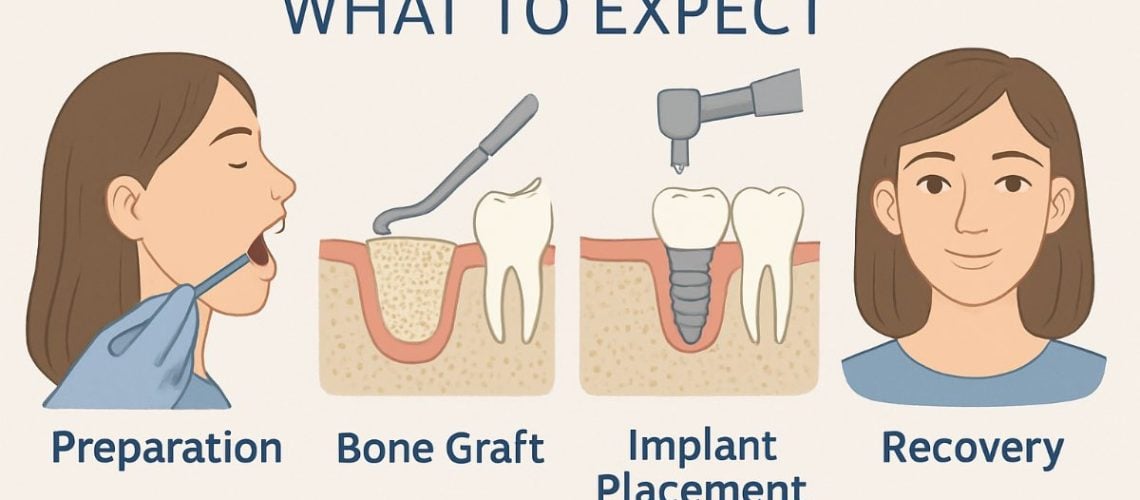This article explains what to expect during bone implant surgery in Dallas–Fort Worth. You’ll learn what bone grafting is, why it may be needed, the types of grafts, the surgical steps, recovery timelines, risks, cost factors, and how to prepare for a consultation. By the end you should feel ready to talk with your surgeon and plan next steps for care.
What Is Bone Graft Surgery For Dental Implants?
Bone grafting rebuilds lost jawbone so it can hold dental implants. The goal is to create a stable, dense foundation for one or more implants. Grafts replace or support missing bone and help the implant fuse firmly to the jaw over time.
Why You Might Need A Bone Graft
You may need a graft if you’ve lost bone from:
- Tooth loss that wasn’t replaced quickly
- Chronic infection around a tooth
- Trauma or injury
- Long-term denture wear that causes ridge collapse
Specific problems that often require grafts include ridge defects and areas where the sinus is very close to the upper jaw. In those cases, bone implant surgery in Dallas–Fort Worth often includes sinus lifts or ridge augmentation to create enough height and width for implants.
Types Of Bone Grafts
Autograft (Your Own Bone)
An autograft uses bone taken from your body. Common donor sites are the chin, jaw, or hip. Advantages: best chance for integration and healing because it’s your living bone. Drawbacks: extra surgical site and longer recovery.
Allograft, Xenograft, And Synthetic Options
Allografts come from human donors; xenografts come from animals; synthetics are lab-made materials. These options avoid a second surgical site and work well for many cases. Healing time varies: some materials integrate faster, while others act as a scaffold that your bone slowly replaces.
Platelet-Rich Fibrin (PRF) And Growth Factors
PRF uses your blood to concentrate healing proteins. Surgeons often mix PRF with graft material or place it over the graft to speed soft-tissue healing and support bone formation. PRF is commonly used in bone implant surgery in Dallas–Fort Worth to reduce swelling and boost predictability.
What To Expect During Bone Implant Surgery
A typical visit follows these steps:
- Pre-op imaging and planning with a CBCT 3D scan to map bone, nerves, and sinuses.
- Anesthesia options: local, oral sedation, or IV sedation depending on case and comfort.
- Incision and preparation of the graft site. The surgeon places graft material and may secure it with membranes or tacks.
- Sometimes implants are placed the same day as the graft (immediate placement); often implants are delayed until the graft heals.
Expect the visit to last an hour or longer based on graft size and complexity.
Recovery Timeline And Aftercare
Immediate symptoms include swelling, mild-to-moderate pain, and some bruising. Typical aftercare tips:
- Use prescribed pain meds and antibiotics as directed.
- Soft diet for several days to weeks depending on the site.
- Keep the mouth clean but avoid disturbing the graft—gentle rinses are usually recommended.
- Avoid heavy exercise and smoking during the initial healing period.
Healing can take weeks for soft tissue and several months for solid bone formation. Many patients wait three to six months before implant placement, though timing varies by graft type and location.
Risks, Complications, And How They’re Reduced
Common risks include infection, graft failure, sinus complications in the upper jaw, and temporary nerve irritation. Surgeons reduce risk with:
- Comprehensive 3D imaging and careful treatment planning
- Sterile surgical technique and appropriate antibiotics
- Use of membranes, tacks, and PRF to protect and stabilize the graft
- Monitoring and early follow-up to catch problems fast
When complications occur, timely care often resolves the issue without losing the graft or implant site.
Cost Factors And Insurance Basics
Price depends on graft type, graft size, need for sinus lifts or multiple sites, anesthesia choice, and any lab or graft materials. Insurance may cover part of the cost for medically necessary grafts but often limits coverage for implant-related work. Many practices offer financing plans or payment options to spread costs for bone implant surgery in Dallas–Fort Worth.
About Texas Center For Oral Surgery & Dental Implants
Texas Center for Oral Surgery & Dental Implants is a family-owned specialist practice serving the Dallas–Fort Worth Metroplex. The center’s board-certified surgeons use in-house CBCT imaging, PRF capability, digital planning tools, and an on-site lab to support predictable grafting and implant outcomes. They offer IV sedation and use technologies like dynamic surgical guidance and 3D-printed guides to improve accuracy and recovery.
Next Steps: Preparing For Your Consultation
Bring any prior X-rays or scans, a list of medications, and a summary of medical history. Key questions to ask:
- Do I need a graft, and what type is best for my case?
- Can implants be placed at the same time as the graft?
- What is the estimated timeline, cost, and follow-up plan?
- What sedation options are available?
To learn more or schedule an evaluation for bone implant surgery in Dallas–Fort Worth, contact the surgical team to set up a consultation and get a personalized treatment plan.

